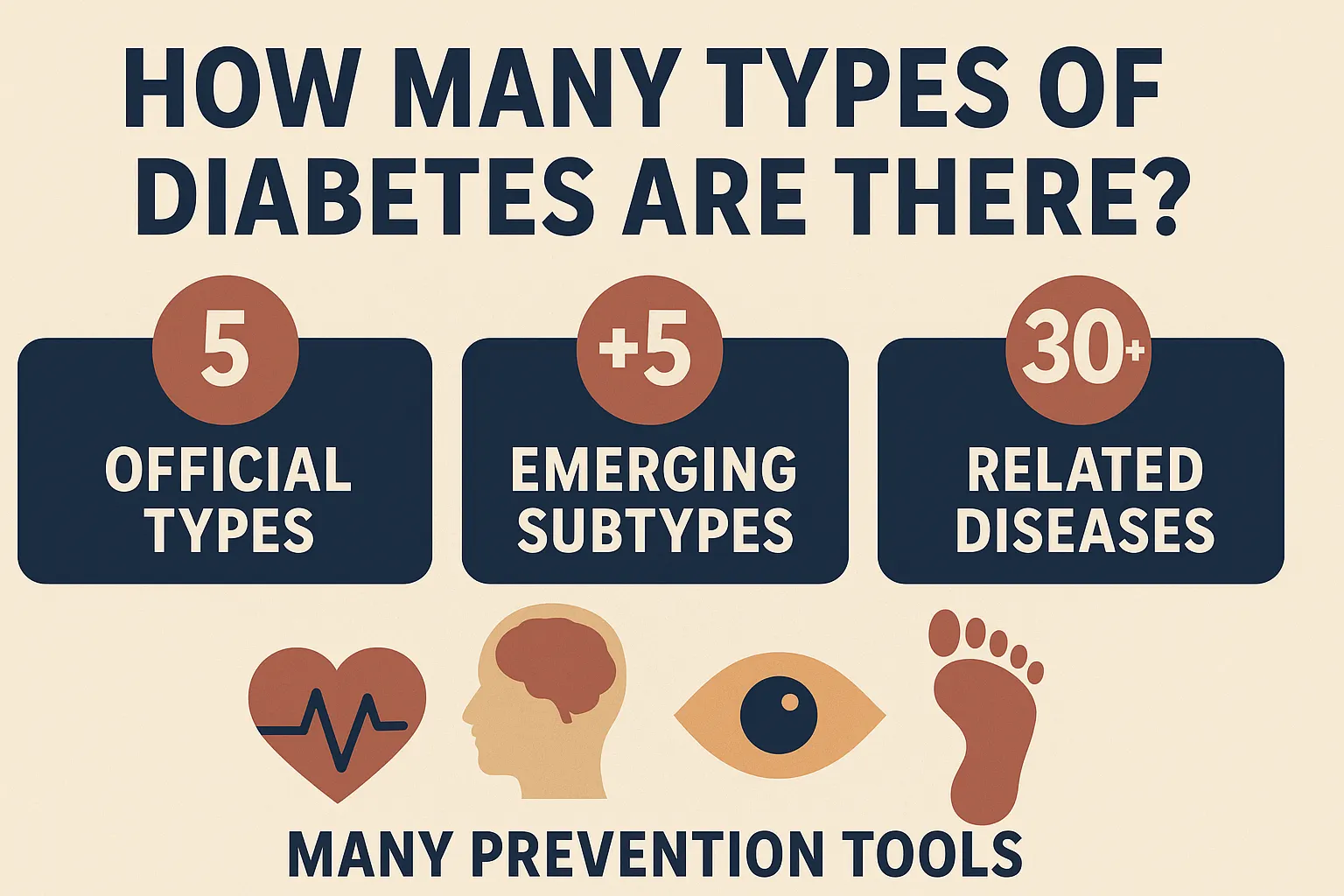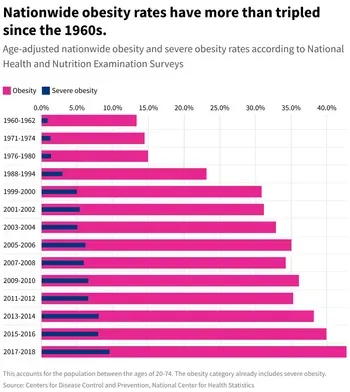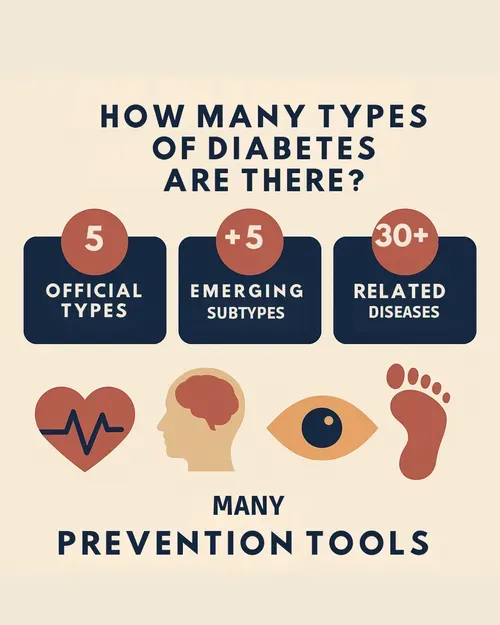🩺 How Many Types of Diabetes Are There? And Just How Many Diseases Are Linked to High Blood Sugar?
In a world where over 1 in 3 adults has blood sugar problems, understanding diabetes is more urgent than ever. And it isn't your grandma's blood sugar problems! We know way more!
The thing with diabetes (or simply, higher-than-normal blood sugars) is that there is no safe higher-than-normal blood sugar level. What I've learned from 40 years of purposefully countering the effects of diabetes with both the best conventional and holistic methods is that high blood sugars impact everything. It causes inflammation, which research proves is linked to everything from Alzheimer's to strokes.
Whether you're navigating your own diagnosis or supporting someone you love, it's essential to know what you're dealing with—and why stable blood sugars matter for your entire body.
This post breaks down how many types of diabetes exist (official and emerging), and reveals the astonishing number of health conditions linked to high blood sugar.

How Many Types of Diabetes Are There?
✅ The 5 Officially Recognized Types of Diabetes
According to the World Health Organization (WHO) and the American Diabetes Association (ADA), there are four primary types:
- Type 1 Diabetes (T1D):
- An autoimmune condition—usually diagnosed in youth—where the pancreas stops producing insulin.
- Type 2 Diabetes (T2D):
- The most common type, often linked to lifestyle and genetics, where the body resists insulin or doesn’t produce enough.
- Gestational Diabetes:
- Occurs during pregnancy and increases future risk of Type 2 for both mother and child.
- Other Specific Types:
- A category that includes rare and secondary forms like MODY (Maturity-Onset Diabetes of the Young), LADA (Latent Autoimmune Diabetes in Adults), steroid-induced diabetes, and pancreatic diabetes.
🧠 Official total: 5 distinct types of diabetes
🔬 Emerging Research: Up to 9 Subtypes?
Groundbreaking research now proposes that diabetes is not a single disease but a spectrum. Experts suggest that at least five additional subtypes exist, based on genetics, immune markers, and insulin response patterns. These aren't officially categorized yet—but they're shaping personalized medicine.
🧬 Expanded total: Up to 9 subtypes of diabetes under consideration
🚨 30+ Diseases and Complications Linked to High Blood Sugar
Here’s the part that doesn’t get talked about enough: diabetes doesn't just affect blood sugar—it affects nearly every organ system in the body. Chronically elevated glucose acts like a slow poison, damaging tissues, nerves, vessels, and immune defenses.
Let’s break it down:
🫀 Cardiovascular (5)
- Heart disease
- Stroke
- High blood pressure
- Atherosclerosis
- Heart failure
🧠 Brain & Neurological (6)
- Peripheral neuropathy
- Autonomic neuropathy
- Cognitive decline
- Alzheimer’s disease (“Type 3 Diabetes”)
- Depression
- Anxiety
👁️ Eye Health (3)
- Diabetic retinopathy
- Cataracts
- Glaucoma
🧬 Kidney & Liver (4)
- Diabetic nephropathy
- Chronic kidney disease (CKD)
- End-stage renal disease
- Fatty liver disease (NAFLD, NASH)
🦶 Feet, Skin & Extremities (4)
- Foot ulcers
- Skin infections
- Amputations
- Diabetic dermopathy
🍽️ Digestive & Metabolic (3)
- Gastroparesis
- High triglycerides
- Metabolic syndrome (includes insulin resistance, obesity, hypertension)
🦠 Immune & Inflammatory (2)
- Frequent infections
- Delayed wound healing
🔬 Reproductive & Hormonal (3)
- Erectile dysfunction
- Fertility issues
- Polycystic ovary syndrome (PCOS)
🦷 Dental & Oral Health (1)
- Gum disease
📉 Estimated Total: 30–35 related conditions and complications
📊 Summary Table
Category Count
Official Diabetes Types 4
Emerging Subtypes (Proposed) +5
Diabetes-Related Conditions 30–35
Grand Total ~40–45🐾
Why This Matters
High blood sugar doesn’t wait until your doctor says “you have diabetes.” Long before a diagnosis, your body may already be under attack. Blood sugar swings can cause mood changes, inflammation, energy crashes, and silently damage your organs—even in people with prediabetes or early insulin resistance.
But here’s the beautiful truth:
You can reverse or delay so much of this.
Through smart nutrition, movement, stress reduction, and support (yes—even from your dog!), you can regain vitality and prevent many of these complications.
🐕 One More Thing… What’s With the Dogs?
Dogs have an incredible ability to detect blood sugar changes through scent. In my coaching work and in my own life, dogs serve as both literal alert systems and symbolic companions—guiding us through the “dogs of diabetes,” helping us reclaim joy, connection, and power.
Managing diabetes may feel like facing Cerberus, the mythical dog guarding the gates of Hades—but with the right tools (and a real dog by your side), those dogs can become guardians of your health.
🧭 Ready to Take Control?
Whether you’re dealing with Type 1, Type 2, prediabetes, or just worried about energy crashes and aging too fast—understanding the numbers is step one.
You are not broken. You are not alone.
And yes—you can thrive with diabetes.
✨ Want support from someone who's walked this path for 40+ years and trained her dog to help with blood sugars? Let’s talk.
About the Author

Karin Collinsworth is a change professional, a passionate integrative and Public Health advocate, a Certified coach & yoga therapist with over 40 years of experience navigating Type 1 Diabetes, metabolic health, and longevity using an easy integrative approach. She’s passionate about helping others stabilize blood sugar, prevent complications, and age vibrantly—all while integrating mindfulness, yoga, and nutrition into daily life.
🐶 She also specializes in training blood sugar alert dogs to help diabetics manage their health more effectively!
🌱 Join the journey: Linktree.com/Karin_C
















